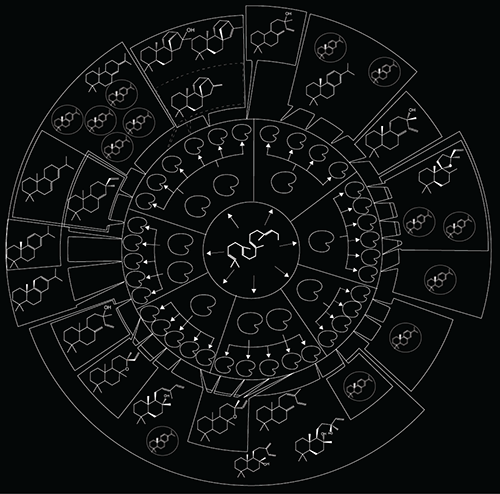PhD defense by Johan Andersen-Ranberg
Title of thesis: Identification and characterization of biosynthetic parts involved in plant diterpenoid biosynthesis
Supervisor: Björn Hamberger
Exam committee: Chair Thomas Günther-Pomorski
External reviewers:
Sarah O’Connor (John Innes Centre)
Harald Heider (Evolva A/S Basel)

Abstract: Plants are the source of a large number of complex diterpenoid natural products of commercial value. Here diTPS and CYP enzymes play the major role in biosynthesis and diversification of diterpenoid natural products. Therefore the functional characterization of diTPS and CYPs is a prerequisite for engineered production of complex diterpenoids in heterologous biotechnological hosts, and provides insights on how biosynthetic enzymes contribute to the diversity of diterpenoids found in plants. Prior to this work, identification of diTPS and CYP genes had been established in transcriptome data from the medicinal plants Coleus forskohlii, Tripterygium wilfordii and Euphorbia peplus, producing forskolin, triptolide and ingenol-3-angelate, respectively. Together with novel CYP genes discovered in the transcriptome from C. forskohlii root cork cells, the previously identified genes were the subject of functional characterization in this thesis. The main system used for this purpose was the agrobacterium mediated transient expression in Nicotiana benthamiana, followed by chemical analysis of extracts.
It could be demonstrated that the C. forskohlii class II diTPS CfTPS2 together with class I diTPSs CfTPS3 or CfTPS4 catalyze the formation of 13R-manoyl oxide, an early intermediate in the forskolin biosynthetic pathway, and found in specialized lipophilic organelles (oil bodies) in the root cork cells from C. forskohlii.
In a synthetic biology approach the N. benthamiana system was furthermore used for functional characterization of new-to-nature diTPS modules consisting of class II and class I diTPS from C. forskohlii, T. wilfordii, E. peplus and selected diTPS from other species. This resulted in the biosynthesis of 47 different distinct diterpenes, displaying inherent substrate and product plasticity of the diTPS modules.
In addition, CYP76AH8, CYP76AH11 and CYP71D381 were identified in the transcriptome of C. forskohlii root cork cells and it was shown that these CYPs catalyzed oxidation of 13R-manoyl oxide. Isolation and purification of the biosynthetic products from CYP71D381 allowed structural identification of 2-hydroxy-manoyl oxide and 19-hydroxymanoyl oxide, which are not considered intermediates in the biosynthetic pathway of forskolin. CYP76AH8 and CYP76AH11 were shown to catalyze collectively four out five oxidation steps of MO en route to forskolin. Two late intermediates in the forskolin biosynthesis, 7-11-dihydroxy-13R-manoyl oxide and 9-deoxy-deacetyl-forskolin were structurally characterized by NMR analysis.
For the overall future goal, biosustainable production of forskolin, using, it was demonstrated in collaborating labs that the microbial hosts Escherichia coli, Saccharomyces cerevisiae and Synechocystis PCC 6803 can be engineered for production of 13R-manoyl oxide, yet at different rates of efficiency.
